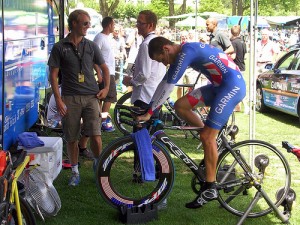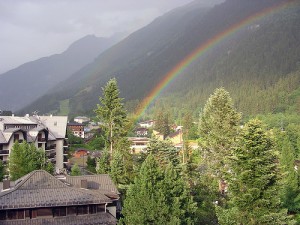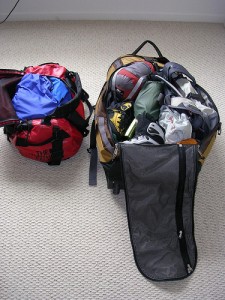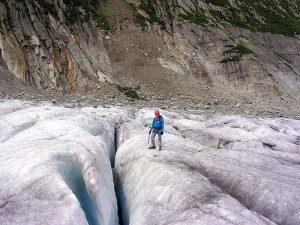
Dave Zabriske warming up at the 2009 Tour de France--tres chic.
Someone I follow on Twitter recently tweeted:
Why don’t cyclists in Boulder wave back when I wave to them?
This is a Boulder cycling phenomenon that is particularly shocking and upsetting to we friendly former Midwesterners. In the Midwest, there aren’t many cyclists, so when you encounter another one, you can’t help but wave in excitement. And I might be biased since I’m from St. Louis, but I think Midwesterners are a friendly bunch. Just ask Garrison Keillor. We’d probably wave even if our roads had more cyclists than cars.
Maybe. (See No. 5 below)
But I remember that feeling on my first rides here 8 years ago: You’re let down, and then feel snubbed, and then you’re just mad enough to spend a ride counting how many people wave back, which means you have a lousy ride and spend most of your post-ride stretch calculating the percentage of unfriendly folks riding bikes in Boulder County.
The poor guy on Twitter did the same thing and arrived at an abysmal number.
I don’t want people to spend rides like this, so I’d like to offer some theories as to why cyclists in Boulder County do not wave.
1. We’re a little self-absorbed and fanatical. Sorry. If someone is training for five charity rides, seven triathlons and an adventure on Kokopelli’s Trail this fall, he or she might be too focused to notice the nice people waving.
2. You might be a gumby. Okay, yes this is harsh. But someone has to tell you the truth. This is a sport with a strict safety code AND a strict fashion code, and sometimes they go hand in hand. If you’re violating the rules of either code, you’re probably viewed as a gumby by the cyclists who have it together, and those cyclists are not going to wave at a gumby.
Here are some clues that you might be a gumby:
-You wear your helmet far back on your head, exposing your forehead. Not only does it look ridiculous to have bangs when you’re wearing a helmet, you’ve rendered your helmet useless for a frontal impact. Are your bangs going to protect your head from the pavement if you faceplant? No. Lower your helmet.
-You ride in a baggy cotton T-shirt and lycra bike shorts. Wearing a cotton T-shirt is only okay if you wear baggy pants with it and ride something with fat tires. Or if you are skilled enough to star in the next MTB flick by the Collective.
-You wear underwear under your bike shorts. Not only is VPL a serious cycling-fashion faux pas, it’s (probably) uncomfortable. (I’ve never done it, so I can’t say for sure.) Bike shorts are designed to be worn right against your skin; let them do their job.
-You’re riding a hybrid, torso bolt upright, on fat tires on Highway 36, and you are unable to take a hand off your bars to grab your water bottle without weaving. First, this bike should be reserved for bike trails in town, not battling wind on the open road. Technically, except for the weaving, the only dangerous thing about this is that everyone on their skinny-tired, aerodynamic little road bikes will blow past you so fast that you’ll become disoriented and end up riding offroad into the buffalo farm off Nelson Road. The good news? Those fat hybrid tires will finally come in handy. (Exception: A friend of mine is riding one of these right now with flat pedals and one leg in a knee-to-toe brace. Riding through an injury is hard core, and being hard core lets you break the rules.)
I know what you’re thinking after all of this gumby-bashing: Jenn Fields is a full-on snob. Not true. We all start as gumbies, and I credit my friends (especially my husband) for teaching me all of this and more right away, thus severely shortening my squirrely gumby stage. Forget about looking goofy–wearing your helmet correctly is a safety concern. And riding fast on skinny tires is just more fun.
I’m also not the only one. There’s communal snobbery in this sport. Case in point: This is a community that adores BikeSnobNYC. (If you read him, you’re probably not a gumby.) And if you think you’re exempt from the snobbery, go ahead, tell me you’ve never thought twice about which socks to wear on a group ride. Tell me you’ve never coordinated your bar tape and your bottle cages. We all know you’re matchy-matchy for reasons of style, not function. Which leads me to…
3. There’s a pecking order. Last year, I joined a club/team, which resulted in me owning a club kit. This was the first time I’d ridden in Boulder in a club kit, and I noticed that when I wore said club kit, I elicited more waves from other people in their various club kits. On days when I wore random jerseys and shorts, I didn’t get many waves from the club/team crowd.
(By the way, joining a club/team made me realize what I love most about cycling–riding alone.)
My husband raced for ages and has noted this pecking-order waving in Boulder, too. Apparently I didn’t just join a club–I joined the club, the club of the teams/clubs with their team/club kits and races. That is the kicker–do you race? If you’re not a racer, the other racers might not wave at you in brotherly race-worn affection. (PS, if you’ve cleaned someone’s post-race road rash, like I have, you know racers earn the right to be in a club of their own. Kudos, racers.) But pay attention, sensitive wavers. If the racers do acknowledge you…
4. Don’t miss the subtle wave. The racers love subtle, casual greetings while riding. It’s much more suave than taking your hand off your bar to wave. (If you take your hand off your bar, you might as well sit up and take both hands off the bars and fiddle with something in your pockets, or make sure your sunglasses are perfectly adjusted over your helmet straps, never under.) A few examples of the subtle greeting:
-Lifting one’s fingers off the bar, but keeping the palm on the bar.
-Lifting a sole finger off the bar, almost pointing at the person. Bang bang. Palm still remains on bar.
-The nod. This one does not require lifting a finger and is especially easy to miss. Thus it is the slickest option and is widely used in Boulder County.
Subtle greetings are also convenient, because…
5. It’s all about the numbers. I thought about trying to count cyclists on my ride today, just for this post. But I knew I would lose track; it was windy, and I had my head down a lot when I had a shoulder to ride on. I’m sure I could have counted at least 30 people on my hour-long ride, probably 40. Some of them were in small groups, true, but–are you really going to wave 40 times in an hour? That’s an average of one wave every minute and a half. It’s enough to cause even the friendliest of Midwesterners a wearing out their welcoming attitude. If you’re new to Boulder or just visiting, don’t be put off by the lack of waves. There are simply too many cyclists to wave at all the time. Most people are nice–I can’t count how many times I’ve seen people slow to ask stopped cyclists if they need a tube or a tool. Remember, a lot of us Coloradans are former Midwesterners, eager to lend a hand in any way we can.



